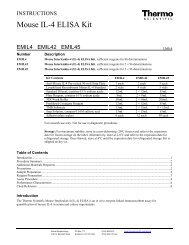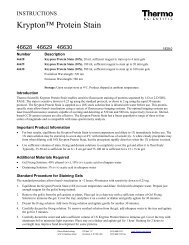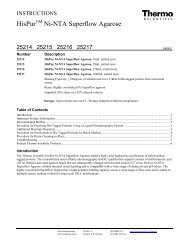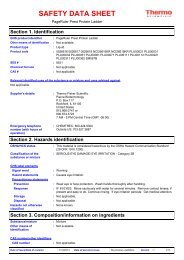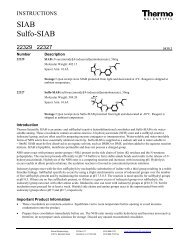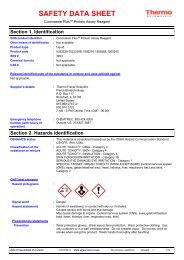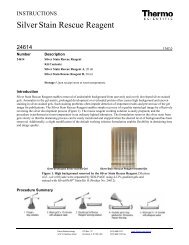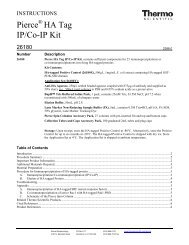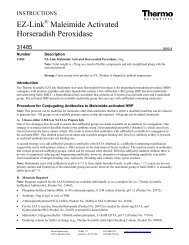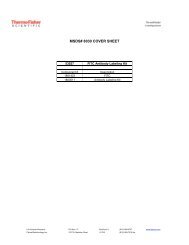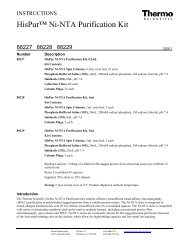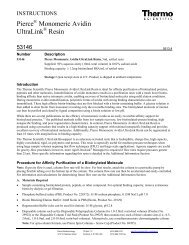Thermo Scientific Pierce Protein Assay Technical Handbook Version 2
Thermo Scientific Pierce Protein Assay Technical Handbook Version 2
Thermo Scientific Pierce Protein Assay Technical Handbook Version 2
You also want an ePaper? Increase the reach of your titles
YUMPU automatically turns print PDFs into web optimized ePapers that Google loves.
<strong>Thermo</strong> <strong>Scientific</strong> Total <strong>Protein</strong> <strong>Assay</strong>s<br />
Time Considerations<br />
The amount of time required to complete a total protein assay<br />
will vary for the different colorimetric, total protein assay<br />
methods presented. To compare the amount of time required to<br />
perform each assay, all seven assays were performed using 20<br />
samples and eight standards (including the blank). Each sample<br />
or standard was assayed in duplicate using the standard tube<br />
protocol (triplicate using the plate). The estimates include times<br />
for both incubation(s) and handling:<br />
• Preparing (diluting) the standard protein in the diluent buffer<br />
(10 minutes)<br />
• Organizing the run and labeling the tubes (5 minutes)<br />
• Pipetting the samples and reagents (10 minutes for 56 tubes,<br />
1 minute per plate)<br />
• Mixing or incubating the tubes or plates (varies)<br />
• Measuring the color produced (15 minutes for 56 tubes or<br />
1 minute per plate)<br />
• Graphing the standard curve, calculating, recording and<br />
reporting the results (30 minutes)<br />
Table 3. Times required to assay 20 samples and 8 standards using the<br />
test tube procedure; handling times are considerably less using the<br />
microplate procedure.<br />
Method Product # Incubation Time Total <strong>Assay</strong> Time<br />
<strong>Pierce</strong> 600nm<br />
<strong>Protein</strong> <strong>Assay</strong><br />
23250 5 minutes 75 minutes<br />
Coomassie Plus<br />
(Bradford) <strong>Assay</strong><br />
23236 10 minutes 80 minutes<br />
Coomassie<br />
(Bradford) <strong>Assay</strong><br />
23200 10 minutes 80 minutes<br />
BCA <strong>Assay</strong> 23225 30 minutes 100 minutes<br />
Modified Lowry<br />
<strong>Assay</strong><br />
BCA <strong>Protein</strong> <strong>Assay</strong><br />
– Reducing Agent<br />
Compatible<br />
23240<br />
10 minutes and<br />
30 minutes<br />
110 minutes<br />
23250 45 minutes 115 minutes<br />
Micro BCA <strong>Assay</strong> 23235 60 minutes 130 minutes<br />
Calculation of Results<br />
When calculating protein concentrations manually, it is best to<br />
use point-to-point interpolation. This is especially important if the<br />
standard curve is nonlinear. Point-to-point interpolation refers<br />
to a method of calculating the results for each sample using the<br />
equation for a linear regression line obtained from just two points<br />
on the standard curve. The first point is the standard that has an<br />
absorbance just below that of the sample and the second point<br />
is the standard that has an absorbance just above that of the<br />
sample. In this way, the concentration of each sample is calculated<br />
from the most appropriate section of the whole standard<br />
curve. Determine the average total protein concentration for<br />
each sample from the average of its replicates. If multiple<br />
dilutions of each sample have been assayed, average the<br />
results for the dilutions that fall within the most linear portion<br />
of the working range.<br />
When analyzing results with a computer, use a quadratic<br />
curve fit for the nonlinear standard curve to calculate the<br />
protein concentration of the samples. If the standard curve<br />
is linear, or if the absorbance readings for your samples fall<br />
within the linear portion of the standard curve, the total protein<br />
concentrations of the samples can be estimated using the linear<br />
regression equation.<br />
Most software programs allow one to construct and print a<br />
graph of the standard curve, calculate the protein concentration<br />
for each sample, and display statistics for the replicates.<br />
Typically, the statistics displayed will include the mean<br />
absorbance readings (or the average of the calculated protein<br />
concentrations), the standard deviation (SD) and the coefficient<br />
of variation (CV) for each standard or sample. If multiple dilutions<br />
of each sample have been assayed, average the results for the<br />
dilutions that fall in the most linear portion of the working range.<br />
References<br />
Krohn, R.I. (2002). The colorimetric detection and quantitation of total protein, Current<br />
Protocols in Cell Biology, A3.H.1-A.3H.28, John Wiley & Sons, Inc.<br />
Krohn, R.I. (2001). The colorimetric determination of total protein, Current Protocols in<br />
Food Analytical Chemistry, B1.1.1-B1.1.27, John Wiley & Sons, Inc.<br />
12<br />
For more information, or to download product instructions, visit www.thermoscientific.com/pierce



